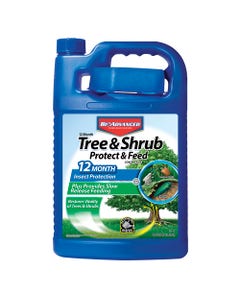

- Home
- Solution Center
- Learn
- Outdoor Pests
- Asian Citrus Psyllid & Citrus Greening Disease
Asian Citrus Psyllid & Citrus Greening Disease
Few pests pose a more daunting threat to citrus than the tiny Asian Citrus Psyllid (ACP), a potential carrier of a disease that could ravage the citrus industry and wipe out trees in home gardens. Because it can spread the bacterial disease called Citrus Greening Disease, aka Huanglongbing (HLB), this insect has sparked intensive quarantine and eradication efforts just about anywhere citrus can be grown outdoors.
What Is This Insect?
ACP is a small insect with needle-like mouthparts used to pierce plants and suck out the juices. The tiny adults look like aphids, measuring about 1/8 inch and characteristically feeding with their tail end raised at a distinct 45 degree angle from the leaf. Their bodies are grayish tan with brown markings and mottled brown wings. The extremely small nymphs are bright orange-yellow and exude a distinctive trail of white, waxy material.

According to the U.S. Department of Agriculture, ACP prefers to feed and reproduce on the new leaf growth of citrus and closely-related plant species, such as:
- Orange Jessamine (Murraya paniculata)
- Sweet Orange and Mandarin Orange
- Lemon
- Lime
- Tangerine
- Grapefruit
- Kumquat
ACP adults and nymphs damage new growth because they inject toxins into the citrus plant or tree while they feed. This causes curling, distortion and blackening of young leaves. Insect populations increase during periods of active plant growth. ACP often carries and transmits a disease called Citrus Greening Disease, aka huanglongbing (HLB). As they feed and inject toxins to distort plant leaves, ACP can infect the citrus host simultaneously.
Citrus Greening Disease
Citrus Greening Disease, or HLB, is considered one of the most devastating citrus diseases, and there is no known cure. ACPs don’t always carry the disease, but the disease can only be spread by the insect or through infected propagating material. Symptoms of the disease include yellowing growth and unevenly ripening, lopsided fruit with a bitter taste. It can take up to three years for Citrus Greening Disease symptoms to be visible in a citrus tree. Infected trees produce inedible fruits and eventually die. Citrus trees infected with the disease must be destroyed.
The disease has devastated commercial citrus industries around the world, causing billions of dollars in damage. In Florida alone, tens of thousands of acres of citrus trees have been removed. Whether grown in orchards or backyards, Citrus Greening Disease threatens the very survival of citrus in the United States and around the world.
Where Is ACP Found?
Most states where citrus can be grown outdoors have quarantines for ACP and/or Citrus Greening Disease. They include Alabama, Arizona, California, Florida, Georgia, Hawaii, Louisiana, Mississippi, Texas and South Carolina. Go to saveourcitrus.org for more information and a map of quarantine areas.
You Can Help Stop The Spread
The only way to prevent the spread of Citrus Greening Disease is to control ACP. Since citrus is such a popular and widely-planted garden tree, homeowners are on the front lines of this important battle. Here’s how you can help:
- Know and follow quarantine rules in your state, especially when it comes to purchasing and moving citrus trees (including citrus relatives), fruit and plant parts.
- Only purchase plants from reputable nurseries and garden centers.
- Do NOT move plants, fruit or plant parts out of your area, especially across state or international borders.
- Consume fruit on your property.
- Dry or double bag plant clippings prior to disposal.
- When grafting trees, only use registered budwood that comes with source documentation.
- Cooperate with officials who need to inspect or treat citrus trees in your yard or neighborhood.
- In quarantined areas, protect your citrus trees against ACP with properly labeled foliar sprays and/or a systemic insecticide soil-drench applied prior to the flush of new growth in late summer or early fall, or in spring after bloom. Carefully follow label instructions.
- BioAdvanced™ Fruit, Citrus & Vegetable Insect Control* offers insect protection** all season long. Best of all there’s no spraying! Simply apply it around the base of your tree for systemic protection from the roots to the tip of every leaf.
What To Do If You Think You Have ACP
Be familiar with signs of ACP and Citrus Greening Disease. Inspect your citrus trees monthly. If they are showing signs of ACP activity or any symptoms of Citrus Greening Disease:
- Go to SaveOurCitrus and click on the “Report It” button. Then follow the instructions.
- Collect damaged samples, seal the samples in a plastic bag, and report it to your county agricultural commissioner immediately.
- In California, call the California Department of Food and Agriculture Pest Hotline at (800) 491-1899. For more information, visit Californiacitrusthreat.org
- In Florida, call the Division of Plant Industry at (800) 282-5153.
- In other areas, contact your local Cooperative Extension System office or your local agricultural commissioner.
Other Resources
SaveOurCitrus can provide a wealth of information on ACP and Citrus Greening Disease, as well as other insects and diseases that threaten citrus. It will direct you to local information on quarantines and on whom to contact. Californiacitrusthreat.org is a valuable resource on all things ACP and citrus greening.
*Not for sale, sale into, distribution, and or use in Nassau, Suffolk, Kings and Queens counties of NY. Reclassified as restricted use in CT & MD.
**Listed insects.
Photo Credit: H.D. Catling, Bugwood.org
















